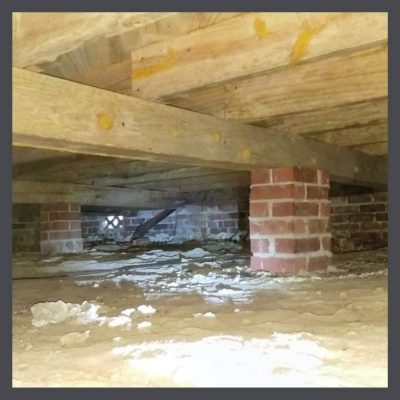 Your bungalow’s foundation was the first thing to be built give or take, 100 years ago. It is still of primary importance. It bears the weight of your house & all its contents- your cast iron bathtub, your refrigerator, your bookshelf. If you live in a cold climate, it also bears the weight of winter snow, which weighs in at about 15 pounds per cubic foot.
Your bungalow’s foundation was the first thing to be built give or take, 100 years ago. It is still of primary importance. It bears the weight of your house & all its contents- your cast iron bathtub, your refrigerator, your bookshelf. If you live in a cold climate, it also bears the weight of winter snow, which weighs in at about 15 pounds per cubic foot.
In this article I am going to address what can adversely affect your foundation. I’m not enthusiastic about warning people about dangers without giving them solutions so I’m including what you can do to ensure that yours stays strong & level.
The ground beneath us moves often, shrinking during dryer times & expanding during wet ones, & does not move uniformly, causing damage to the supporting piers of your bungalow’s foundation.
STEPS TO TAKE TO PROTECT YOUR BUNGALOW’S FOUNDATION
1. Plant trees well away from your exterior walls. The Arbor Day Foundation recommends that you plant a medium (30’- 40’) tree at least 15’ away from a wall. A taller tree. Such as an oak, needs to be at least 20’. Most tree roots spread 2-3 times the radius of the canopy, & often reach out 5 times the radius of the tree canopy & in dry conditions, they can spread even further. As they grow, they disrupt the soil.
Some trees have more invasive roots, some that are water-seeking. Replacing a root-infested main drain pipe (which carries all the water from your house to the city connection or to your septic tank) typically requires excavation, which makes a mess in your yard & can be hideously expensive. Trees with invasive roots may need a minimum distance of 25 to 50’. Slow-growing trees generally have less destructive roots than those that grow quickly. Before you plant a tree, find out about how its root system will behave.
2. Take a deep breath!
Your foundation needs to breath. If water gets underneath your house, it must be able to dry out. A non-vented crawl-space is dangerous to your foundation & your floors. Read this article on how you can help it get some much needed air.
3. Remove dead trees, stumps & root systems from areas near the house. They attract termites & your bungalow, depending on wood beams to support it doesn’t need to be weakened by the gnawing of termites.
 4. Install gutters. They channel rainwater from your roof to downspouts & keep your beds from getting washed out. But here’s the trick, you need to install gutter extenders or your gutter will pour all that water right onto your foundation. You need at least 8’ extenders to take that water away. This is most important if you live in a wet area, like I do in Florida, or during the rainy season even in a dryer climate. You can move the ends of the extenders around so that no one area is getting too much water, or, you can choose plants far from your house that would appreciate the extra soaking. I attached several together & put them on my bananas. My neighbors stopped answering their doors when I’d show up with yet more banana bread! You can get extenders at any big box hardware store, or even on Amazon. They are cheap, very easy to install & remove & take up little space in storage. Honest, you need them.
4. Install gutters. They channel rainwater from your roof to downspouts & keep your beds from getting washed out. But here’s the trick, you need to install gutter extenders or your gutter will pour all that water right onto your foundation. You need at least 8’ extenders to take that water away. This is most important if you live in a wet area, like I do in Florida, or during the rainy season even in a dryer climate. You can move the ends of the extenders around so that no one area is getting too much water, or, you can choose plants far from your house that would appreciate the extra soaking. I attached several together & put them on my bananas. My neighbors stopped answering their doors when I’d show up with yet more banana bread! You can get extenders at any big box hardware store, or even on Amazon. They are cheap, very easy to install & remove & take up little space in storage. Honest, you need them.
5. Be alert for leaks. If you suddenly find yourself with an unusually high water bill one month, get suspicious. Leakage can occur in any pipes, your water heater, your ice maker in your refrigerator- a biggy. In my 45 years in the wood flooring business, this was our most common repair.
6. Drainage lines can leak & create problems with you bungalow’s foundation too. We owned a house in which it was discovered that the shower was not hooked up to the sewage system. All the water drained under the house! We’d had the house “inspected” but this was not noticed & had been going on for decades.
Do not overlook the draining of your HVAC’s condensate lines. Under the indoor unit of your HVAC system, there sits a large metal pan. When you run your air conditioner, water collected from the air in the form of condensation will drip out of the unit & flow into the drain pan. From the collection pan, it flows into the drain line & then through a pipe & out your bungalow. You need to make sure that the drain line is not clogged or the pan will overflow, & you need to have that pipe long enough so that the water is not running out close to your house.
7. How is the grading around your house? Does water run away from or toward the foundation? Hopefully this was included in your inspection, but it can be overlooked. Notice where the water runs in a heavy rain.
8. If you find that you are having problems with water sitting under your bungalow, & you determine that your grading is tipped the wrong way, you can have French drains installed to move the water away from your bungalow’s foundation.
 9. When you are doing your hardscaping or landscaping keep in mind the idea that you don’t want to build up your beds so that they are higher than the ground around your house, especially if you have raised borders that will trap rain or irrigation. You don’t want to be building little ponds around your 100 year old masonry piers! If you have raised borders, monitor your irrigation & use gutter extenders to keep heavy rain out of them.
9. When you are doing your hardscaping or landscaping keep in mind the idea that you don’t want to build up your beds so that they are higher than the ground around your house, especially if you have raised borders that will trap rain or irrigation. You don’t want to be building little ponds around your 100 year old masonry piers! If you have raised borders, monitor your irrigation & use gutter extenders to keep heavy rain out of them.
10. Let’s talk about your irrigation system. My husband has been called to inspect homes which have developed cupped (wood) floors & found that the irrigation system was hitting the house. Even if it’s not directly hitting it, your sprinkler heads need to be pointed away from your bungalow’s foundation. It’s a good idea to inspect the system routinely to see if it has sprung any leaks that might be hitting your house or causing water to flow under the house.
11. Keep your plants away from your house. You need to be able to inspect your piers & peer underneath your house to see what’s going on every once in a while. (I never said home ownership is for sissies.)
 12. Protect your bungalow’s foundation from termite damage. I’m going to toss you over to a Bora-Care video to tell you about the product. Then I’d like for you to watch a video on a more toxic product Sentricon.
12. Protect your bungalow’s foundation from termite damage. I’m going to toss you over to a Bora-Care video to tell you about the product. Then I’d like for you to watch a video on a more toxic product Sentricon.
I use both. I had the attic & crawlspace of my bungalow sprayed with Bora-Care & then I installed Sentricon at the perimeter. I don’t know why the Sentricon video presents it as an either/or situation. They each have their place your termite arsenal.
I was lucky to have discovered a wonderful home inspector whom I could call when I had things going on with my house that looked scary. He figured out why my bedroom wall was cracking (water under the house which is how I learned about gutter extenders) & he successfully tracked a leak missed by a bunch of leak detection guys at my friend’s house.
When you own a house & especially when you own a 100 year old bungalow, you need someone who knows more than you do that you can trust. A good inspector is worth her weight in gold before you purchase & as your home changes through the years.
TIP: LEARN MORE ABOUT FOUNDATIONS FROM THE GREAT VIDEOS HERE.
 STAY IN THE BUNGALOW KNOW!!!
STAY IN THE BUNGALOW KNOW!!!
Sign up for our newsletter & receive our FREE E-book, 7 VITAL Things to Do Before You Hire a Contractor.



0 Comments